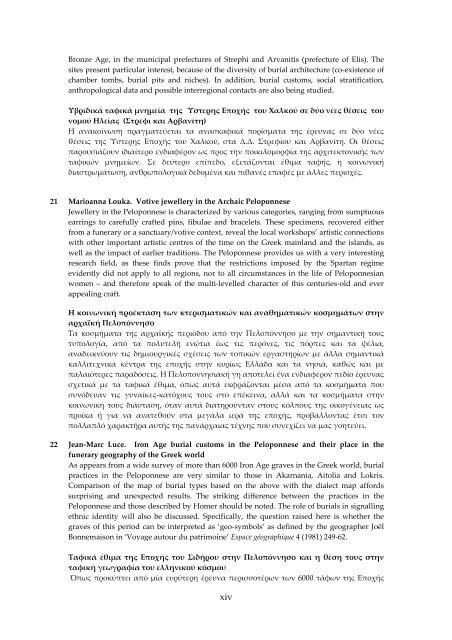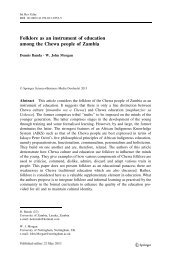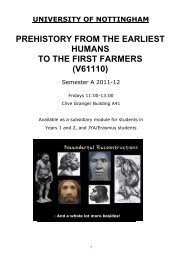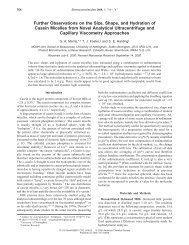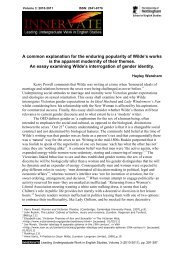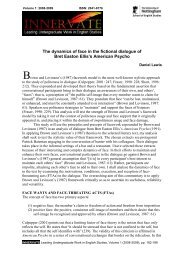Honouring the Dead in the Peloponnese - University of Nottingham
Honouring the Dead in the Peloponnese - University of Nottingham
Honouring the Dead in the Peloponnese - University of Nottingham
You also want an ePaper? Increase the reach of your titles
YUMPU automatically turns print PDFs into web optimized ePapers that Google loves.
Bronze Age, <strong>in</strong> <strong>the</strong> municipal prefectures <strong>of</strong> Strephi and Arvanitis (prefecture <strong>of</strong> Elis). The<br />
sites present particular <strong>in</strong>terest, because <strong>of</strong> <strong>the</strong> diversity <strong>of</strong> burial architecture (co-existence <strong>of</strong><br />
chamber tombs, burial pits and niches). In addition, burial customs, social stratification,<br />
anthropological data and possible <strong>in</strong>terregional contacts are also be<strong>in</strong>g studied.<br />
Υβριδικά ταφικά μνημεία της Ύστερης Εποχής του Χαλκού σε δύο νέες θέσεις του<br />
νομού Ηλείας (Στρεφι και Αρβανίτη)<br />
Η ανακοίνωση πραγματεύεται τα ανασκαφικά πορίσματα της έρευνας σε δύο νέες<br />
θέσεις της Ύστερης Εποχής του Χαλκού, στα Δ.Δ. Στρεφίου και Αρβανίτη. Οι θέσεις<br />
παρουσιάζουν ιδιαίτερο ενδιαφέρον ως προς την ποικιλομορφία της αρχιτεκτονικής των<br />
ταφικών μνημείων. Σε δεύτερο επίπεδο, εξετάζονται έθιμα ταφής, η κοινωνική<br />
διαστρωμάτωση, ανθρωπολογικά δεδομένα και πιθανές επαφές με άλλες περιοχές.<br />
21 Marioanna Louka. Votive jewellery <strong>in</strong> <strong>the</strong> Archaic <strong>Peloponnese</strong><br />
Jewellery <strong>in</strong> <strong>the</strong> <strong>Peloponnese</strong> is characterized by various categories, rang<strong>in</strong>g from sumptuous<br />
earr<strong>in</strong>gs to carefully crafted p<strong>in</strong>s, fibulae and bracelets. These specimens, recovered ei<strong>the</strong>r<br />
from a funerary or a sanctuary/votive context, reveal <strong>the</strong> local workshops’ artistic connections<br />
with o<strong>the</strong>r important artistic centres <strong>of</strong> <strong>the</strong> time on <strong>the</strong> Greek ma<strong>in</strong>land and <strong>the</strong> islands, as<br />
well as <strong>the</strong> impact <strong>of</strong> earlier traditions. The <strong>Peloponnese</strong> provides us with a very <strong>in</strong>terest<strong>in</strong>g<br />
research field, as <strong>the</strong>se f<strong>in</strong>ds prove that <strong>the</strong> restrictions imposed by <strong>the</strong> Spartan regime<br />
evidently did not apply to all regions, nor to all circumstances <strong>in</strong> <strong>the</strong> life <strong>of</strong> Peloponnesian<br />
women – and <strong>the</strong>refore speak <strong>of</strong> <strong>the</strong> multi-levelled character <strong>of</strong> this centuries-old and ever<br />
appeal<strong>in</strong>g craft.<br />
Η κοινωνική προέκταση των κτερισματικών και αναθηματικών κοσμημάτων στην<br />
αρχαϊκή Πελοπόννησο<br />
Τα κοσμήματα της αρχαϊκής περιόδου από την Πελοπόννησο με την σημαντική τους<br />
τυπολογία, από τα πολυτελή ενώτια έως τις περόνες, τις πόρπες και τα ψέλια,<br />
αναδεικνύουν τις δημιουργικές σχέσεις των τοπικών εργαστηρίων με άλλα σημαντικά<br />
καλλιτεχνικά κέντρα της εποχής στην κυρίως Ελλάδα και τα νησιά, καθώς και με<br />
παλαιότερες παραδόσεις. Η Πελοποννησιακή γη αποτελεί ένα ενδιαφέρον πεδίο έρευνας<br />
σχετικά με τα ταφικά έθιμα, όπως αυτά εκφράζονται μέσα από τα κοσμήματα που<br />
συνόδευαν τις γυναίκες-κατόχους τους στο επέκεινα, αλλά και τα κοσμήματα στην<br />
κοινωνική τους διάσταση, όταν αυτά διατηρούνταν στους κόλπους της οικογένειας ως<br />
προίκα ή για να ανατεθούν στα μεγάλα ιερά της εποχής, προβάλλοντας έτσι τον<br />
πολλαπλό χαρακτήρα αυτής της πανάρχαιας τέχνης που συνεχίζει να μας γοητεύει.<br />
22 Jean-Marc Luce. Iron Age burial customs <strong>in</strong> <strong>the</strong> <strong>Peloponnese</strong> and <strong>the</strong>ir place <strong>in</strong> <strong>the</strong><br />
funerary geography <strong>of</strong> <strong>the</strong> Greek world<br />
As appears from a wide survey <strong>of</strong> more than 6000 Iron Age graves <strong>in</strong> <strong>the</strong> Greek world, burial<br />
practices <strong>in</strong> <strong>the</strong> <strong>Peloponnese</strong> are very similar to those <strong>in</strong> Akarnania, Aitolia and Lokris.<br />
Comparison <strong>of</strong> <strong>the</strong> map <strong>of</strong> burial types based on <strong>the</strong> above with <strong>the</strong> dialect map affords<br />
surpris<strong>in</strong>g and unexpected results. The strik<strong>in</strong>g difference between <strong>the</strong> practices <strong>in</strong> <strong>the</strong><br />
<strong>Peloponnese</strong> and those described by Homer should be noted. The role <strong>of</strong> burials <strong>in</strong> signall<strong>in</strong>g<br />
ethnic identity will also be discussed. Specifically, <strong>the</strong> question raised here is whe<strong>the</strong>r <strong>the</strong><br />
graves <strong>of</strong> this period can be <strong>in</strong>terpreted as ‘geo-symbols’ as def<strong>in</strong>ed by <strong>the</strong> geographer Joël<br />
Bonnemaison <strong>in</strong> ‘Voyage autour du patrimo<strong>in</strong>e’ Espace géographique 4 (1981) 249-62.<br />
Ταφικά έθιμα της Εποχής του Σιδήρου στην Πελοπόννησο και η θέση τους στην<br />
ταφική γεωγραφία του ελληνικού κόσμου<br />
Όπως προκύπτει από μία ευρύτερη έρευνα περισσοτέρων των 6000 τάφων της Εποχής<br />
xiv


